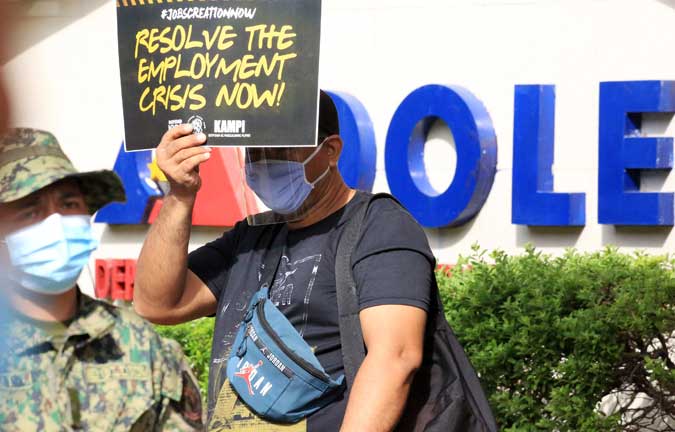Many firms laid off workers in Metro Manila when nearly all economic activity was halted during the strictest lockdown in the second quarter of 2020. — PHILIPPINE STAR/ EDD GUMBAN
MORE WORKERS were laid off than were hired among large Metro Manila firms during the second quarter last year at the height of the strictest lockdown, Philippine Statistics Authority (PSA) data released on Monday showed.
In its latest Labor Turnover Survey, the PSA said labor turnover in the National Capital Region (NCR) declined by 7.6% in the second quarter last year, worse than the -1.4% in the preceding three-month period and a reversal of the 1.1% expansion posted in the second quarter of 2019.
The latest turnover rate is equivalent to a reduction of 76 workers for every 1,000 persons employed in these establishments during the period.
The labor turnover rate is the difference between the rate of hiring (accession) and the rate of job termination or resignation (separation).
“It’s difficult to find other reasons for the decline in labor statistics aside from the pandemic,” University of Asia and the Pacific Senior Economist Cid L. Terosa said in an e-mail.
“Firms were unprepared for a crisis of this magnitude. I would say that the secondary reasons include the lack of business resiliency and adaptability due to below-par business continuity planning, risk analysis, and crisis management,” Mr. Terosa added.
To recall, the government placed Luzon under an enhanced community quarantine in March 2020 to prevent the spread of coronavirus disease 2019 (COVID-19). Unemployment soared to 10.3% last year from 5.1% in 2019.
PSA data also showed the rate of accession – which represents hiring by employers to either replace former employees or expand their workforce – stood at 4.4% in the second quarter, lower than the 9.3% in the previous quarter.
The rate of separation stood at 12%, up from the first quarter’s 10.7%.
Of the employer-initiated separations, 65.8% were attributed to the COVID-19 pandemic that led to these workers being temporarily laid-off or placed on floating status. Other primary reasons for termination cited in the survey include “project completion/end of contract” (12.4%) and “retrenchment/downsizing” (10.2%).
Meanwhile, resignations account for the majority of employee-initiated separations at 84.9%, followed by absence without leave (12.7%) and retirement (2.5%).
Among those who resigned, 25.2% were hired by another company while 23.3% and 12.2% cited “personal issues” and “family considerations,” respectively. Other reasons included the pandemic (10.7%), further studies (3.4%), work abroad (1.9%), and health issues (1.5%).
Among the major economic sectors, services posted the largest net negative labor turnover at 8.1%, following an accession rate of 5% and separation rate of 13%.
Likewise, negative job creation rates were observed in industry (-5.1%) and agriculture, forestry and fishing (-0.8%). For industry, its separation rate of 6.7% outpaced its accession rate of 1.7%. Likewise, agriculture’s 1.6% separation rate exceeded its accession rate of 0.7%.
The PSA survey also showed 63,888 job vacancies in the second quarter, fewer than the 85,426 unfilled positions in the first quarter.
These vacancies were highest in the services sector, which accounted for 91.3% of the total, or 58,307 openings. The share of the industry sector was 8.6% (5,522) while that of agriculture, forestry and fishing was 0.1% (58).
By occupation group, employers mostly looked to fill openings for clerical support workers (43.9% of job vacancies); professionals (22.1%); technicians and associate professionals (13.4%); managers (12.3%); and craft and related trades workers (4.3%).
The pandemic affected many establishments’ daily operations during the second quarter, with 16.9% seeing a decline in sales. Respondents also cited temporary closures (10.2%), financial/income loss (8.5%), lack of manpower (7.7%), and limited customers (7.5%).
More than half of the firms surveyed implemented “alternative work arrangements,” while others complied with health and safety protocols (22.1%), and provided shuttle services for employees (5.8%).
OUTLOOK
Philippine Exporters Confederation, Inc. President Sergio R. Ortiz-Luis, Jr. said in a phone interview that labor conditions would likely improve, but noted the extent of recovery will differ by firm or industry depending on the nature of their operations as well as their capability to observe safety protocols.
For University of the Philippines Professor Emeritus Rene E. Ofreneo, reopening the economy does not necessarily lead to more hiring and fewer separations, explaining that some industries are “primed to go up” such as construction firms while other industries such as tourism “remain weak and sluggish,” he said in an e-mail.
Asked on when jobs figures would rebound to pre-pandemic levels, Mr. Ofreneo said “maybe 2022 or even beyond.”
In a separate e-mail, ING Bank N.V. Manila Senior Economist Nicholas Antonio T. Mapa is not optimistic on the prospects of the labor market.
“[W]e can expect job attrition to remain elevated with replacement not likely to offset job losses due to business struggles or outright closures,” he said.
The 2020 labor turnover survey covering the first and second quarters involved 1,206 Metro Manila-based establishments with 20 or more employees. The survey was conducted from August to October 2020. – Abigail Marie P. Yraola

